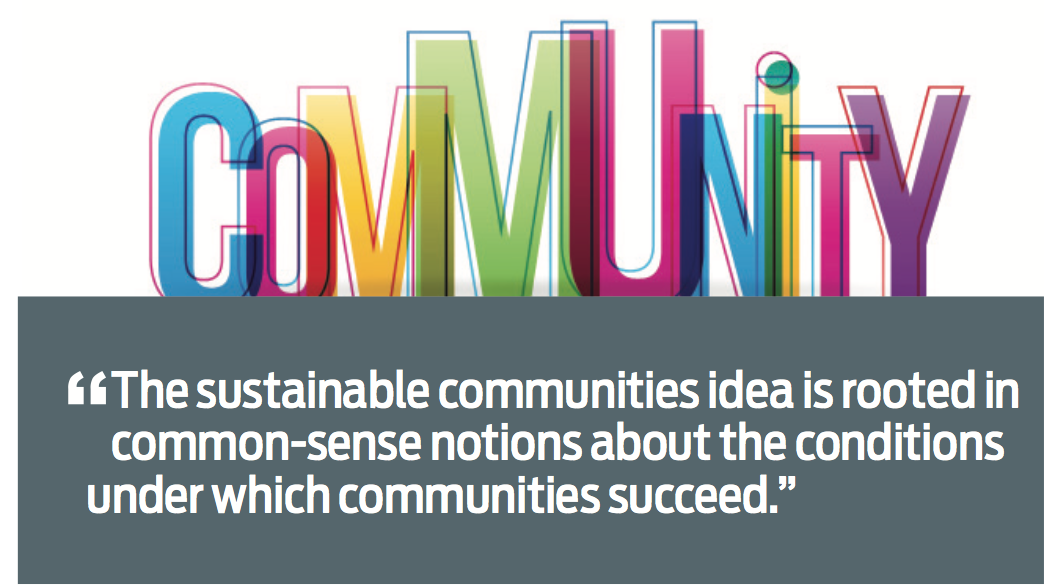Housing affordability is a crucial ingredient in any thriving community. And yet, in cities and towns across the country, there is a growing recognition that truly “sustainable communities” can be created only when multiple forces come into play. The cost of a home is only one of those factors.
The sustainable communities idea is rooted in common-sense notions about the conditions under which communities succeed. For instance, a company cannot thrive unless its employees can afford to live near their jobs. An affordable home cannot be sustained unless employment opportunities are nearby. A working family – even one whose rent or mortgage payment is affordable – cannot prosper long-term without access to transportation or health care near that home.
Sustainable communities form where this interlocking web of support and opportunities exist together.
Employment
Increasingly, communities have an economic self-interest in preserving and expanding affordable housing options even in high-growth, high-cost markets. Workforce housing – or available, affordable housing near where people are employed – is critical for moderate-income employees, who are vital to the communities they serve. New models of affordable housing require collaborations between non-profit and for-profit housing developers, cities, states and major employers, and must expand to meet the need.
Health care
Sustainable communities offer residents healthy, toxin-free homes, as well as basic health care services and wellness programs that encourage healthy, active lifestyles. Research has shown that buildings with healthy design features – like playgrounds, community gardens and tobacco-free policies – and enhanced resident health and wellness services have a measurable positive impact on the health and stability of low-income renters. After being sworn into office, U.S. Department of Housing and Urban Development Secretary Ben Carson explained that years of working directly with patients and their families taught him there is a deep relationship between health and housing.
Transportation
In rural areas, people may have housing but lack the ability to commute to a job. Even in major cities, crowded highways, aging infrastructure and inadequate mass transit are daunting and sometimes insurmountable obstacles for a working family. Better infrastructure and transportation planning, and a commitment to invest, will be a key ingredient in developing sustainable communities in the decades to come.
Education
The quality of education one receives has a direct correlation with ZIP code. In other words, the higher the cost of living, the better chance one has to receive quality educational opportunities. A good educational foundation leads to increased chances of attending higher education institutions and creates the long-term ability to land high-growth, high-paying jobs. But in areas where education lacks resources and the impoverished areas impact students’ quality of life  and ability to concentrate on school, the generational poverty is cyclical and the opportunities are limiting. Education helps to create sustainable communities, or communities where your educational opportunities aren’t limited by where you live. Access to quality education in underserved communities improves outcomes and closes achievement gaps.
and ability to concentrate on school, the generational poverty is cyclical and the opportunities are limiting. Education helps to create sustainable communities, or communities where your educational opportunities aren’t limited by where you live. Access to quality education in underserved communities improves outcomes and closes achievement gaps.
Sustainable communities are being created, in many cases, by for-profit entities with a pro-social mission. For instance, San Diego-based Comunidad Realty Partners has created a commercially viable model of workforce housing that incorporates social impact programs such as after school programs, job development, financial literacy, affordable health care and energy conservation into its very business model. Comunidad’s social impact philosophy is embodied in its slogan: “People, Planet, Profit.” Throughout the Sunbelt states, Comunidad has developed, preserved and operated nearly 9,000 multifamily rental units that are models for sustainable community development at scale.
At Fannie Mae, we created the Sustainable Communities Innovation Challenge, a two-year, $10 million commitment to foster new ideas that address our mission to bring access and affordability of credit to underserved markets. Contract awardees to-date include Nationwide Children’s Hospital in Columbus, Ohio, which is expanding an affordable workforce housing development with an integrated onsite healthcare workforce training program, as well as affordable rental housing within one mile of the hospital.
These efforts are about more than meeting a need for affordable housing. They are a reaffirmation of an old truth: Thriving homes and sustainable communities go hand-in-hand, a symbiotic relationship in which one is not possible without the other.






